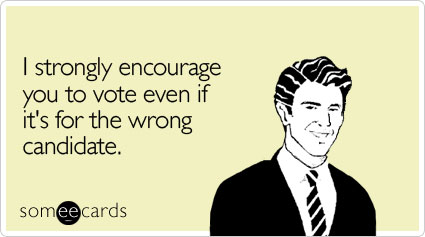![https://brandtao.files.wordpress.com/2007/08/groupthink.gif?w=411&h=231]()
In August, I reported the Arizona Supreme Court had directed the creation of a state bar task force to review “The Role and Governance Structure of the State Bar of Arizona.” But knowing how things roll around here, I had no expectations of meaningful reforms. In the words of Laurence J. Peter, “Bureaucracy defends the status quo long past the time when the quo has lost its status.”
Groupthinking task force.
![http://upload.wikimedia.org/wikipedia/commons/thumb/6/66/Groupthink_Model.jpg/320px-Groupthink_Model.jpg]()
Arizona Bar leadership is notorious for group-think; tone-deafness; and smug self-congratulation. Far as Bar leadership’s concerned, ‘Everything Is AWESOME!!!‘
![business,attire,suits,cheering,emotions,excitement,facial expressions,groups,hands up,happy,jumping,men,people,women]()
Business as usual.
![Entertainment 606]() The task force has met five times and even started prepping its “initial, and very rough, draft report.” But ‘fugetaboutit,’ there’s nothing to clap about.
The task force has met five times and even started prepping its “initial, and very rough, draft report.” But ‘fugetaboutit,’ there’s nothing to clap about.
Zero-based inquiry? Dissenting opinions? After reading five meeting minutes, save for cosmetic changes consisting of renaming the Bar’s board; seating fewer board members; and imposing overdue term limits — it’s clear without dissenters on the task force, it was preordained business as usual.
![]()
When thirty-six percent of the task force is composed of past members of the Bar’s board of governors, four of them also past presidents, including the immediate past president — expect no surprises.
Then there’s this, the appointed task force “consultant” ‘splainin‘ things to underinformed task force public members is the Bar’s well-paid CEO. Or as former Italian prime minister Silvio Berlusconi once said, “If I, taking care of everyone’s interests, also take care of my own, you can’t talk about a conflict of interest.” A mission and governance review with such guiding lights is like hunting with the game warden.
![Bored]() The recommendations so far:
The recommendations so far:
“#1: The Task Force recommends amendments to Supreme Court Rule 32(a) to clarify that the mission of the State Bar of Arizona is primarily to protect and to serve the public, and secondarily, to serve its members.
“#2: The Task Force recommends “restyling” Rule 32(a) for clarity and for easier comprehension.
“#3: The name of the board of governors should be changed to the board of trustees. This change acknowledges the fiduciary responsibility of board members . . . .
![]() “#4: The size of the board should be reduced to 15 to 18 voting members. The Task Force recommends a board of 15 members.
“#4: The size of the board should be reduced to 15 to 18 voting members. The Task Force recommends a board of 15 members.
“#5: Some members of the board should be selected through an electoral process, and other members should be appointed.
“#6: A significant portion of the board should be public members who have no financial interest in the practice of law . . . .
![]() “#7: To assure that appointed members have the skills and experience necessary for service on the board, a process should be created for recruitment, vetting, and nomination of appointees . . . .
“#7: To assure that appointed members have the skills and experience necessary for service on the board, a process should be created for recruitment, vetting, and nomination of appointees . . . .
“#8: Board members should serve staggered terms to preserve continuity of leadership and institutional knowledge.
![Politicians 34]() “#9: Board members should have term limits. The number of terms depends on the length of terms, but generally, board members should serve no more than 8-12 years.
“#9: Board members should have term limits. The number of terms depends on the length of terms, but generally, board members should serve no more than 8-12 years.
“#10: Attorney members of the board, whether elected or appointed, should have no less than 5 years’ experience as lawyers, and a clean disciplinary record for the 5 years preceding service on the board.
“#11: Court rules should include a process for removing board members for good cause. The Task Force did not define “good cause,” but it might include commission of serious crimes, commencement of or sanction for formal discipline, etc. The Task Force proposes removal of a board member on a two-thirds vote of the board, conditioned on the Court’s ratification.
![LAW AND JUSTICE 12]() “#12: Ex officio members bring value to the board. The immediate past president of the bar, and an associate Supreme Court justice, should serve on the board as ex officio, non-voting members. The Court should appoint one law school dean as an ex officio member, with the appointment rotating annually or bi-annually among the deans of Arizona’s law schools.
“#12: Ex officio members bring value to the board. The immediate past president of the bar, and an associate Supreme Court justice, should serve on the board as ex officio, non-voting members. The Court should appoint one law school dean as an ex officio member, with the appointment rotating annually or bi-annually among the deans of Arizona’s law schools.
“#13: The leadership track of the board of trustees should consist of three officers: a president, a president-elect, and a secretary-treasurer, who should serve one-year terms of office.”
Having the cake and eating it, too.
![]()
The task force glanced at the 148-page report submitted by the Task Force on the Role of the State Bar of Michigan — but like the guy that licks the frosting but leaves the cake, the task force only liked Michigan’s affirmation of mandatory membership. The rest was irrelevant.
![This file is licensed under Creative Commons Attribution ShareAlike 2.0 Germany License.]()
Creative Commons Attribution ShareAlike 2.0 Germany License.
To the surprise of possibly only a squirrel with a backpack, Arizona’s task force recommended “that Arizona continue to have a mandatory (integrated) bar.” See Mission & Governance Draft Minutes
As for the Arizona Bar’s posture concerning the reason the Michigan State Bar Task Force was created, i.e., whether as a mandatory bar, the Michigan Bar could fulfill “its core mission of service to the public and our members within the constitutional boundaries defined by Keller v. State Bar of California” — well, that was given short shrift.
Not like it mattered that the genesis of the Michigan Task Force was a state bar letter to the Michigan Supreme Court opposing a Michigan Bill to make bar membership voluntary. Noting that the bill raised “questions about the operation of the State Bar as a mandatory organization that are most appropriately addressed within the judicial branch pursuant to the Supreme Court’s exclusive constitutional authority . . . For that reason, we write to request that the Supreme Court initiate a review of how the State Bar operates within the framework of Keller v. State Bar of California, 496 US 1 (1990).”
![]() But since the State Bar of Arizona back-pats itself “Keller-pure” – the task force opted not to go there. ‘We’re good.’ Ditto on the Bar’s programs, services and activities — its amazingness is everywhere!
But since the State Bar of Arizona back-pats itself “Keller-pure” – the task force opted not to go there. ‘We’re good.’ Ditto on the Bar’s programs, services and activities — its amazingness is everywhere!
To review all meeting minutes and related documents go to AZCourts.gov
______________________________________________________________________
Photo Credits: cartoon source “group think or team win” by brandtao;chart based on Irving Janis groupthink model by HaleyB3, Wikimedia Commons, Creative Commons attribution;11326426096.jpg and 113264261341.jpg by sideshowmom at Morguefile.com; Nom cake! by Sirenz Lorraine at Flickr via Creative Commons Attribution-NoDerivs License.
![]()
![]()
 And so I found myself pondering the quote, “I listen to what you say, but I hear what you mean.” It was attributed to Agatha Christie’s famed Belgian detective Hercule Poirot, as played by actor David Suchet.
And so I found myself pondering the quote, “I listen to what you say, but I hear what you mean.” It was attributed to Agatha Christie’s famed Belgian detective Hercule Poirot, as played by actor David Suchet.






 On Sunday, the local paper ran an editorial long on conceit but short on illumination.
On Sunday, the local paper ran an editorial long on conceit but short on illumination. 
 For all its self-congratulated value during its 22 year existence, the JPR Commission has generally functioned as an election cycle rubber-stamp consistently grading judges with mean evaluation scores
For all its self-congratulated value during its 22 year existence, the JPR Commission has generally functioned as an election cycle rubber-stamp consistently grading judges with mean evaluation scores  Since Arizona
Since Arizona 
 That the Commission almost always fails to muster “Does Not Meet” standards votes — or that it rarely votes to non-retain — or that an overwhelmed electorate has to play
That the Commission almost always fails to muster “Does Not Meet” standards votes — or that it rarely votes to non-retain — or that an overwhelmed electorate has to play 

 As an experienced criminal defense lawyer, Cicchini properly points out that this kind of caseload is “nearly impossible” for any lawyer — let alone a newbie hoping to do thorough, ethically unimpeachable legal work for clients.
As an experienced criminal defense lawyer, Cicchini properly points out that this kind of caseload is “nearly impossible” for any lawyer — let alone a newbie hoping to do thorough, ethically unimpeachable legal work for clients.

 But here was the irony and the not insignificant brass. Along with Justice
But here was the irony and the not insignificant brass. Along with Justice 














 However, none of these so-called clues are
However, none of these so-called clues are 


 Starting in law school, continuing till the final hour’s billed, and doubtless, just before the toe tag’s attached, there’ll be a marketer trying to wrest a lawyer’s last discretionary death’s door dollar. This was true back when conventional wisdom held lawyers were dependably fertile targets thanks to all that money they supposedly made.
Starting in law school, continuing till the final hour’s billed, and doubtless, just before the toe tag’s attached, there’ll be a marketer trying to wrest a lawyer’s last discretionary death’s door dollar. This was true back when conventional wisdom held lawyers were dependably fertile targets thanks to all that money they supposedly made.
 In an era of selfies and self-promoting
In an era of selfies and self-promoting 







 Of course, the Court will never approve this petition and will most likely deny it without explanation. Still, kudos to Mr. Mitchell for daring so eloquently and so wittily to expose what most of us already knew, MCLE is bare of verifiable, substantiated argument.
Of course, the Court will never approve this petition and will most likely deny it without explanation. Still, kudos to Mr. Mitchell for daring so eloquently and so wittily to expose what most of us already knew, MCLE is bare of verifiable, substantiated argument. To which I cheer, “Bravo, bravo, bravo!”
To which I cheer, “Bravo, bravo, bravo!”

 When last I mentioned the Arizona Bar’s law practice economics survey in 2010, “
When last I mentioned the Arizona Bar’s law practice economics survey in 2010, “
 The data is also the only lawful means to uncover what other lawyers are charging without running afoul of posted minimum fee schedules. That stratagem was banned almost 40 years ago by
The data is also the only lawful means to uncover what other lawyers are charging without running afoul of posted minimum fee schedules. That stratagem was banned almost 40 years ago by 







 A number of years ago when lawyering was not even a twinkle in my eye, I traveled to Flagstaff, Arizona on overnight business. For dinner that evening, my employee suggested of all things — that we have sushi. Ever dubious, I asked, “Sushi in the desert?” Well, he found a restaurant and we tried it. And let’s just say it wasn’t good.
A number of years ago when lawyering was not even a twinkle in my eye, I traveled to Flagstaff, Arizona on overnight business. For dinner that evening, my employee suggested of all things — that we have sushi. Ever dubious, I asked, “Sushi in the desert?” Well, he found a restaurant and we tried it. And let’s just say it wasn’t good. Last night with no thanks to
Last night with no thanks to 
 In sum, if Portland, Oregon where I spent time last summer is
In sum, if Portland, Oregon where I spent time last summer is 


 And while Arizona’s tourism boosters and business types want very much for the Super Bowl to
And while Arizona’s tourism boosters and business types want very much for the Super Bowl to  I had bats on my mind yesterday. First there was the report Thursday about
I had bats on my mind yesterday. First there was the report Thursday about  Then also last night, I read not about bats but brickbats thrown by the Ninth Circuit over another case of prosecutorial malfeasance. Railing as I have over time,
Then also last night, I read not about bats but brickbats thrown by the Ninth Circuit over another case of prosecutorial malfeasance. Railing as I have over time, 



 As for myself, unlike
As for myself, unlike 
 Last month I received the Arizona Bar’s annual sponsorship solicitation letter ‘inviting’ members to underwrite the convention as “Convention Patrons.” Suggested donations range from $200 plus to $4000 plus. The Nevada Bar, where I also belong, likewise
Last month I received the Arizona Bar’s annual sponsorship solicitation letter ‘inviting’ members to underwrite the convention as “Convention Patrons.” Suggested donations range from $200 plus to $4000 plus. The Nevada Bar, where I also belong, likewise  All well and good — except locally. The Arizona State Bar holds its annual meetings in June and in Arizona — hardly a climatically pleasant locale that time of year. Summer around here means
All well and good — except locally. The Arizona State Bar holds its annual meetings in June and in Arizona — hardly a climatically pleasant locale that time of year. Summer around here means 

 The other NPR quiz show panelists
The other NPR quiz show panelists 
 If the Arizona Bar hasn’t thought of it, NBC News Anchor
If the Arizona Bar hasn’t thought of it, NBC News Anchor 





 “#4: The size of the board should be reduced to 15 to 18 voting members. The Task Force recommends a board of 15 members.
“#4: The size of the board should be reduced to 15 to 18 voting members. The Task Force recommends a board of 15 members. “#7: To assure that appointed members have the skills and experience necessary for service on the board, a process should be created for recruitment, vetting, and nomination of appointees . . . .
“#7: To assure that appointed members have the skills and experience necessary for service on the board, a process should be created for recruitment, vetting, and nomination of appointees . . . .



 But since the State Bar of Arizona back-pats itself
But since the State Bar of Arizona back-pats itself  Long time readers know I’m continually inspired by ‘seize-the-day’ true believers of any age and persuasion, but especially by those still sucking the marrow out of life — even as the sun ebbs.
Long time readers know I’m continually inspired by ‘seize-the-day’ true believers of any age and persuasion, but especially by those still sucking the marrow out of life — even as the sun ebbs.
